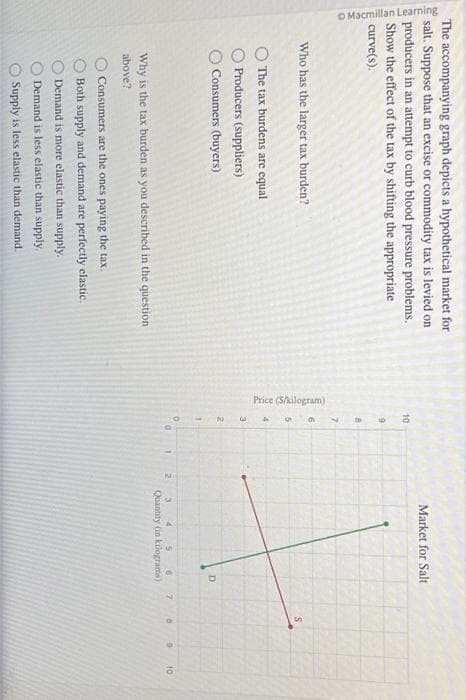Who has the larger tax burden? O The tax burdens are equal O Producers (suppliers) O Consumers (buyers) Why is the tax burden as you described in the question above? Consumers are the ones paying the tax. Both supply and demand are perfectly elastic. Demand is more elastic than supply. Demand is less elastic than supply. O Supply is less elastic than demand.
Who has the larger tax burden? O The tax burdens are equal O Producers (suppliers) O Consumers (buyers) Why is the tax burden as you described in the question above? Consumers are the ones paying the tax. Both supply and demand are perfectly elastic. Demand is more elastic than supply. Demand is less elastic than supply. O Supply is less elastic than demand.
Principles of Macroeconomics (MindTap Course List)
8th Edition
ISBN:9781305971509
Author:N. Gregory Mankiw
Publisher:N. Gregory Mankiw
Chapter8: Application: The Costs Of Taxation
Section: Chapter Questions
Problem 3CQQ
Related questions
Question
Solve Question 2
Hand written solutions are strictly prohibited.

Transcribed Image Text:The accompanying graph depicts a hypothetical market for
salt. Suppose that an excise or commodity tax is levied on
producers in an attempt to curb blood pressure problems.
Show the effect of the tax by shifting the appropriate
curve(s).
O Macmillan Learning
Who has the larger tax burden?
The tax burdens are equal
Producers (suppliers)
Consumers (buyers)
Why is the tax burden as you described in the question
above?
Consumers are the ones paying the tax.
Both supply and demand are perfectly elastic.
Demand is more elastic than supply.
Demand is less elastic than supply.
Supply is less elastic than demand.
Price (S/kilogram)
10
9
8
7
6
4
3
N
1
0
0
1
2
Market for Salt
D
4 5 6
Quantity (in kilograms)
7 8
9
10
Expert Solution
This question has been solved!
Explore an expertly crafted, step-by-step solution for a thorough understanding of key concepts.
This is a popular solution!
Trending now
This is a popular solution!
Step by step
Solved in 3 steps with 1 images

Knowledge Booster
Learn more about
Need a deep-dive on the concept behind this application? Look no further. Learn more about this topic, economics and related others by exploring similar questions and additional content below.Recommended textbooks for you

Principles of Macroeconomics (MindTap Course List)
Economics
ISBN:
9781305971509
Author:
N. Gregory Mankiw
Publisher:
Cengage Learning

Microeconomics: Principles & Policy
Economics
ISBN:
9781337794992
Author:
William J. Baumol, Alan S. Blinder, John L. Solow
Publisher:
Cengage Learning

Essentials of Economics (MindTap Course List)
Economics
ISBN:
9781337091992
Author:
N. Gregory Mankiw
Publisher:
Cengage Learning

Principles of Macroeconomics (MindTap Course List)
Economics
ISBN:
9781305971509
Author:
N. Gregory Mankiw
Publisher:
Cengage Learning

Microeconomics: Principles & Policy
Economics
ISBN:
9781337794992
Author:
William J. Baumol, Alan S. Blinder, John L. Solow
Publisher:
Cengage Learning

Essentials of Economics (MindTap Course List)
Economics
ISBN:
9781337091992
Author:
N. Gregory Mankiw
Publisher:
Cengage Learning

Principles of Microeconomics (MindTap Course List)
Economics
ISBN:
9781305971493
Author:
N. Gregory Mankiw
Publisher:
Cengage Learning

Principles of Macroeconomics (MindTap Course List)
Economics
ISBN:
9781285165912
Author:
N. Gregory Mankiw
Publisher:
Cengage Learning

Principles of Economics 2e
Economics
ISBN:
9781947172364
Author:
Steven A. Greenlaw; David Shapiro
Publisher:
OpenStax